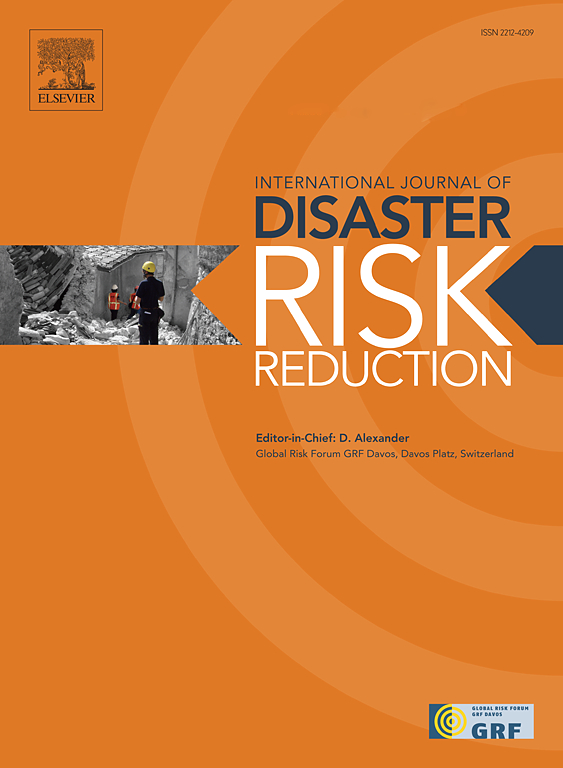Risk analysis of underground debris flows in mines based on a coupled weighted Bayesian network
IF 4.2
1区 地球科学
Q1 GEOSCIENCES, MULTIDISCIPLINARY
International journal of disaster risk reduction
Pub Date : 2024-11-01
DOI:10.1016/j.ijdrr.2024.104922
引用次数: 0
Abstract
Mines mined by the natural caving method are prone to underground debris flow disasters, resulting in mud gushing blocking roadways, equipment damage and even casualties, which seriously affect the safe operation of mines. To carry out a risk analysis of underground debris flows in mines, quantify the interactions among risk factors in the process of disasters, and identify the main disaster-causing paths, DEMATEL-ISM was used to analyze 18 risk factors related to material sources, geology, water sources and processes. A multilevel network structure model was constructed, and the model was mapped to a Bayesian network (BN). Based on the N-K model, the degree of risk coupling was calculated, the nodes in the BN were coupled and weighted, and diagnostic reasoning for underground debris flows was realized based on posterior probability. The results showed that the risk of debris flow increases with increasing coupling factor. The factors of water source, geology and ore drawing ranked at the top in terms of the probability change rate of the BN nodes, and a main disaster-causing path was obtained by diagnostic reasoning, which provides a theoretical basis for the formulation of underground debris flow prevention and control measures.
基于耦合加权贝叶斯网络的矿井地下泥石流风险分析
采用自然崩落法开采的矿井容易发生井下泥石流灾害,造成涌泥堵塞巷道、设备损坏甚至人员伤亡,严重影响矿井安全生产。为了对矿山井下泥石流灾害进行风险分析,量化灾害发生过程中各风险因素之间的相互作用,明确主要致灾路径,本文采用 DEMATEL-ISM 分析方法,分析了与物源、地质、水源、工艺等相关的 18 个风险因素。构建了多层次网络结构模型,并将该模型映射到贝叶斯网络(BN)。在 N-K 模型的基础上,计算了风险耦合度,对 BN 中的节点进行耦合和加权,并根据后验概率实现了地下泥石流的诊断推理。结果表明,泥石流风险随着耦合系数的增加而增加。水源、地质、拉矿等因素在 BN 节点概率变化率中排名靠前,通过诊断推理得到了主要致灾路径,为制定地下泥石流防治措施提供了理论依据。
本文章由计算机程序翻译,如有差异,请以英文原文为准。
求助全文
约1分钟内获得全文
求助全文
来源期刊

International journal of disaster risk reduction
GEOSCIENCES, MULTIDISCIPLINARYMETEOROLOGY-METEOROLOGY & ATMOSPHERIC SCIENCES
CiteScore
8.70
自引率
18.00%
发文量
688
审稿时长
79 days
期刊介绍:
The International Journal of Disaster Risk Reduction (IJDRR) is the journal for researchers, policymakers and practitioners across diverse disciplines: earth sciences and their implications; environmental sciences; engineering; urban studies; geography; and the social sciences. IJDRR publishes fundamental and applied research, critical reviews, policy papers and case studies with a particular focus on multi-disciplinary research that aims to reduce the impact of natural, technological, social and intentional disasters. IJDRR stimulates exchange of ideas and knowledge transfer on disaster research, mitigation, adaptation, prevention and risk reduction at all geographical scales: local, national and international.
Key topics:-
-multifaceted disaster and cascading disasters
-the development of disaster risk reduction strategies and techniques
-discussion and development of effective warning and educational systems for risk management at all levels
-disasters associated with climate change
-vulnerability analysis and vulnerability trends
-emerging risks
-resilience against disasters.
The journal particularly encourages papers that approach risk from a multi-disciplinary perspective.
 求助内容:
求助内容: 应助结果提醒方式:
应助结果提醒方式:


